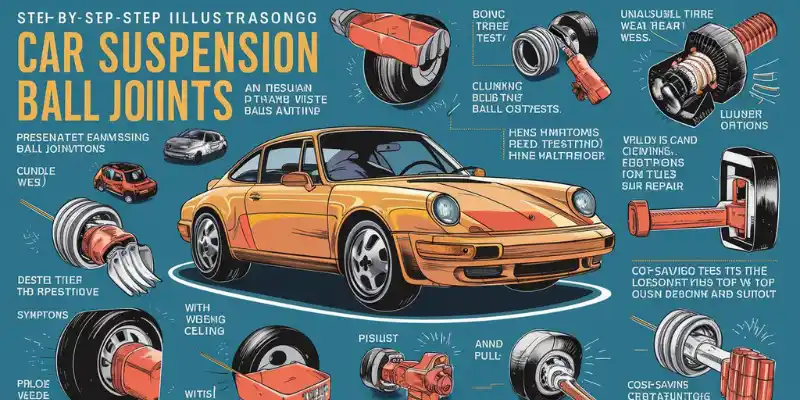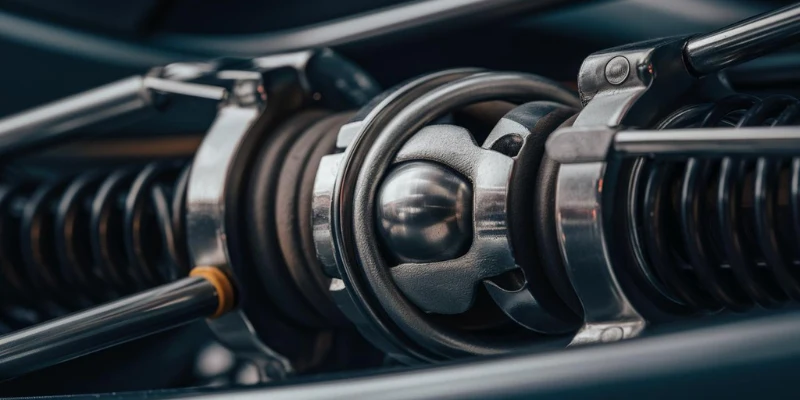Top Methods for Testing Car Suspension Ball Joints: Symptoms, Testing And Costs
Updated: August 14, 2024
118
Maintaining your car’s suspension system is crucial for a smooth and safe ride. One key component that often needs attention is the ball joint, especially in vehicles with a McPherson suspension system. But how do you know if your ball joints are in good shape? In this article, we’ll walk you through the process of testing your car’s ball joints, using simple steps that anyone can follow.
What is a Car Suspension Ball Joint?
The McPherson suspension system is widely used in modern vehicles due to its simplicity and efficiency. At the heart of this system are the ball joints, small but mighty components that connect the control arms to the steering knuckles. Think of them as the pivots that allow your wheels to move up and down smoothly while steering left or right.

Without healthy ball joints, your car’s handling can suffer, leading to uneven tire wear, poor steering response, and even dangerous driving conditions. In this article, we’ll explore how to test these crucial components and ensure your car stays safe on the road.
Why Are Ball Joints Important?
Ball joints might be small, but they play a big role in your car’s suspension system. They allow the suspension to move while keeping the wheels in proper alignment. If the ball joints wear out, it can lead to many problems, from minor annoyances to serious safety concerns.
Worn ball joints can cause:
| Reasons |
|---|
|
Symptoms of Worn Ball Joints in Suspension of Car
How can you tell if your ball joints might be in trouble? Here are some common symptoms:
- Clunking noises: This is often the first sign. If you hear a clunking noise when driving over bumps, your ball joints may be worn.
- Vibrations: If your steering wheel vibrates while driving, it could be due to worn ball joints.
- Uneven tire wear: Check your tires. If they’re wearing unevenly, it could be a sign that your ball joints are worn.
- Loose steering: If your steering feels loose or unresponsive, it’s time to check those ball joints.
Safely Preparing to Test Car Suspension Ball Joints
Before diving into the testing process, it’s essential to ensure safety. Always work on a flat, stable surface, and use wheel chocks to prevent the car from rolling. Wearing gloves and safety glasses is also recommended to protect yourself from any debris or sharp objects.
Tools You’ll Need
To test your car’s ball joints, you’ll need a few basic tools:
| Tool | Purpose |
|---|---|
| Floor jack | To lift the car. |
| Jack stands | To securely hold the car in place while you work. |
| Tire iron | To remove the wheels. |
| Pry bar | For testing the play in the ball joints. |
| Flashlight | To inspect the ball joints more closely. |
Step-by-Step Guide to Testing Car Suspension Ball Joint
Now that you’re prepared let’s get into the testing process. We’ll cover three common methods: the visual inspection, the lift and shake test, and the pry bar test.
Visual Inspection Method 1
Visual inspection is the simplest method and can often give you a quick indication of whether your ball joints are in good shape.
- Lift the Car: Use the floor jack to lift the front of the car and place it securely on jack stands.
- Remove the Wheel: Use the tire iron to remove the front wheel, which will give you clear access to the ball joint.
- Inspect the Ball Joint: Look for any signs of damage, such as torn rubber boots, grease leakage, or rust. These are all signs that the ball joint may be worn and need replacing.
Lift and Shake Test Method 2
The lift and shake test is a more hands-on approach to checking the ball joints.
- Lift the Car: As in the visual inspection, lift the front of the car and secure it on jack stands.
- Grab the Tire: With the wheel still on the car, grab the tire at the 12 o’clock and 6 o’clock positions.
- Shake the Tire: Try to rock the tire back and forth. If you feel any play or movement, it could indicate that the ball joint is worn.
“Ball joints are a vital component of your car’s suspension system. Knowing how to test them correctly can save you from costly repairs and ensure your vehicle remains in top condition.” Lisa Johnson, Car Maintenance Specialist
Pry Bar Test Method 3
The pry bar test is another effective way to check for play in the ball joints.
- Lift the Car: Once again, lift the front of the car and secure it on jack stands.
- Insert the Pry Bar: Place the pry bar under the control arm, close to the ball joint.
- Lift Gently: Apply gentle pressure to the pry bar and observe the ball joint. If you see any movement or play, it’s a sign that the ball joint is worn and may need replacing.

What Do Your Test Results Mean of Ball Joints Car Suspension?
After performing these tests, you should have a good idea of the condition of your ball joints. Here’s what your results might mean:
- No Play or Movement: If you didn’t notice any play or movement during the tests, your ball joints are likely in good shape.
- Some Play or Movement: If you notice a small amount of play, the ball joint may be starting to wear out. It’s a good idea to monitor it closely.
- Excessive Play or Movement: If there is significant play or movement, it’s time to replace the ball joint as soon as possible.
When to Replace Ball Joints
| Indicator | Description |
|---|---|
| Clunking or Knocking Sounds | Unusual noises from the suspension system when driving over bumps or turning. |
| Excessive Play or Loose Steering | Increased steering wheel play or loose steering feel, particularly when turning. |
| Uneven Tire Wear | Uneven or abnormal tire wear patterns that are not due to alignment issues. |
| Vibration or Noise When Driving | Vibrations or noise coming from the suspension, especially during acceleration. |
| Visual Inspection | Visible signs of wear or damage to the ball joints during a visual inspection. |
| Steering Wheel Pulling | The steering wheel pulling to one side or becoming hard to control. |
| Suspension Movement | Excessive movement or bouncing of the suspension when driving over bumps. |
| Ball Joint Boot Damage | Cracked, torn, or damaged boot covering the ball joint, leading to potential contamination. |
Cost of Replacing Ball Joints
The cost of replacing ball joints can vary depending on your vehicle and where you have the work done. On average, you can expect to pay between $200 and $400 per ball joint, including labor. It’s always a good idea to get a few quotes before deciding where to have the work done.
Preventive Maintenance Tips
| Tips |
|---|
|
Conclusion
Testing your car’s ball joints, especially in a McPherson suspension system, is a crucial step in maintaining your vehicle’s safety and performance. By following the steps outlined in this guide, you can easily assess the condition of your ball joints and take appropriate action if needed. Remember, keeping an eye on these small but vital components can save you from more significant issues down the road.
FAQs
How often should I check my car’s ball joints?
It’s a good idea to check your ball joints every 10,000 to 20,000 miles or during regular maintenance checks.
Can I drive with worn ball joints?
Driving with worn ball joints is risky and can lead to more severe suspension damage. It’s best to replace them as soon as you notice a problem.
What happens if a ball joint fails while driving?
If a ball joint fails while driving, it can cause you to lose control of the vehicle, potentially leading to an accident.
Can I replace just one ball joint, or should I replace them in pairs?
It’s generally recommended to replace ball joints in pairs (both sides) to ensure even wear and handling.
What other suspension components should I check when inspecting ball joints?
When checking your ball joints, also inspect the control arms, tie rods, and bushings for any signs of wear or damage.
Please Write Your Comments